TL;DR: What Makes 'Infinite Jest' a Postmodern Classic? A Rapid Summary Guide
Feb 09, 2024 · 2 mins read
0
Share
"Infinite Jest," a tome by David Foster Wallace, is a postmodern epic that's as challenging as it is rewarding, weaving a complex narrative tapestry that mirrors our fragmented reality.
Save
Share
Published in 1996, it marked the dawn of post-postmodern literature, a labyrinthine journey into addiction, entertainment, and the search for meaning.
Save
Share
The novel's title refers to a film within the story, so entertaining that viewers lose all desire for anything else, a metaphor for our own media-saturated culture.
Save
Share
Wallace's work is a totalizing force, a super-weapon of a book that captures the reader with its depth, reflecting on happiness and irony in a society that caters to every whim.
Save
Share
The characters, particularly Hal Incandenza, Don Gately, and Mario Incandenza, embody a range of human conditions, from despair to redemption, akin to biblical narratives.
Save
Share
Wallace's prescient commentary on post-postmodernism shows a world where irony and entertainment have rendered genuine human connection and communication nearly catatonic.
Save
Share
The novel's structure, with its endnotes and non-linear timeline, forces readers to engage actively, mirroring the effort required to navigate the complexities of modern life.
Save
Share
"Infinite Jest" is not just a story but a mythic exploration of the human condition, challenging readers to consider their own values and the meaning of salvation.
Save
Share
Wallace's own struggles with depression and addiction bleed into the narrative, offering a raw and authentic exploration of these issues, far ahead of its time.
Save
Share
"Infinite Jest" remains a cult classic, not just for its intellectual rigor but for its emotional resonance, a testament to Wallace's genius in capturing the zeitgeist of an era.
Save
Share
0
